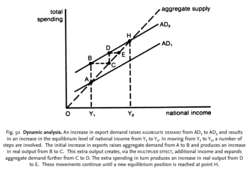
Fig. 50 Dynamic analysis. An increase in export demand raises AGGREGATE DEMAND from AD1 to AD2 and results in an increase in the equilibrium level of national income from Y1 to Y2. In moving from Y1 to Y2, a number of steps are involved. The initial increase in exports raises aggregate demand from A to B and produces an increase in real output from B to C. This extra output creates, via the MULTIPLIER EFFECT, additional income and expands aggregate demand further from C to D. The extra spending in turn produces an increase in real output from D to E. These movements continue until a new equilibrium position is reached at point H.
dynamic analysis
a method of economic analysis that traces out the path of adjustment from one state of EQUILIBRIUM to another. Consider, for example, the effects of a change of the export demand on the EQUILIBRIUM LEVEL OF NATIONAL INCOME. See COMPARATIVE STATIC EQUILIBRIUM ANALYSIS, DISEQUILIBRIUM.Collins Dictionary of Economics, 4th ed. © C. Pass, B. Lowes, L. Davies 2005